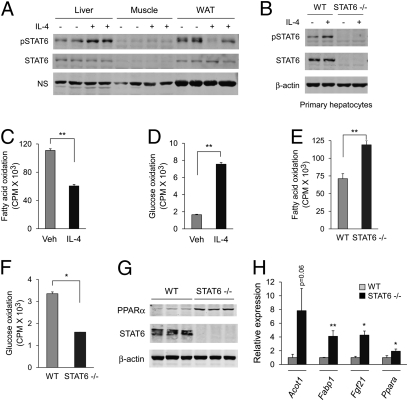Fig. 1.
IL-4 and STAT6 regulate liver nutrient metabolism. (A) IL-4 enhances phosphorylation of STAT6 in the liver, but not skeletal muscle or WAT. NS, nonspecific. (B) STAT6 is expressed in primary hepatocytes and becomes tyrosine-phosphorylated in response to IL-4. (C and D) IL-4 regulates macronutrient metabolism in isolated primary hepatocytes. Changes in rates of fatty acid (C) and glucose oxidation (D) in hepatocytes treated with IL-4 (10 ng/mL). (E and F) STAT6 regulates fuel oxidation in primary hepatocytes. Rates of fatty acid (E) and glucose oxidation (F) in wild-type and STAT6-null hepatocytes. (G and H) Induction of PPARα and its transcriptional program in livers of STAT6−/− mice. (G) Immunoblotting for PPARα and STAT6 in wild-type and STAT6-null livers. β-actin is used as a loading control. (H) Quantitative RT-PCR analyses for PPARα and its target genes, acyl-CoA thioesterase 1 (Acot1), fatty-acid binding protein 1 (Fabp1), and fibroblast growth factor 21 (Fgf21), in livers of wild-type and STAT6−/− mice. All results are displayed as means ± SEM n > 3. *P < 0.05; **P < 0.01.

